Your cart is currently empty!
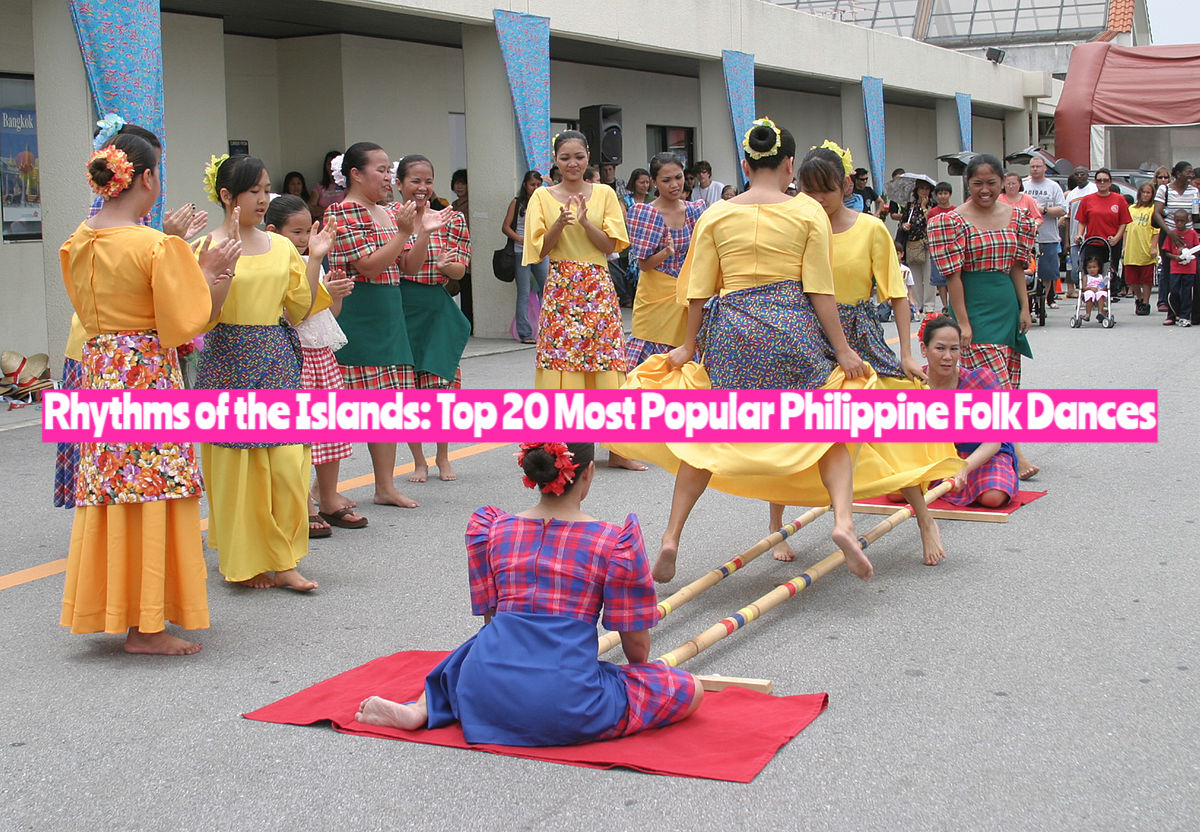
Rhythms of the Islands: Top 20 Most Popular Philippine Folk Dances
The Philippines, a nation rich in cultural diversity and vibrant tradition, holds a vibrant array of awe-inspiring folk dances. These dances are far more than entertainment; they’re an embodiment of the history, communal values, individual stories, and cultural symbolism that breathe life into the fabric of Philippine society.
From the gracefully executed movements in ‘Tinikling’ to the flirtatious charm of ‘Carinosa,’ each dance unravels a narrative worth admiring. They’re a bridge connecting the past to the present, allowing the nation’s rich cultural wealth to flow through generations. These folk dances represent a tableau of life in its varied forms, from courtship rituals like the ‘Pantomina’ to ceremonial dances like ‘Subli’ that invoke divine favor.
Each dance, choreographed with finesse and years of inherited expertise, unveils different facets of Philippine life. Hailing from diverse regional backgrounds, these dances reveal tales of local communities, their values, beliefs, and day-to-day life in vivid displays of rhythm and motion.
This compilation sheds light on the top 20 most popular Philippine folk dances that are a spectacle to behold. Each dance embodies an enthralling blend of agility, rhythm, and narrative, intricately woven into the very essence of our vibrant nation. Dive in and immerse yourself in the captivating world of Philippine folk dances.
Tinikling
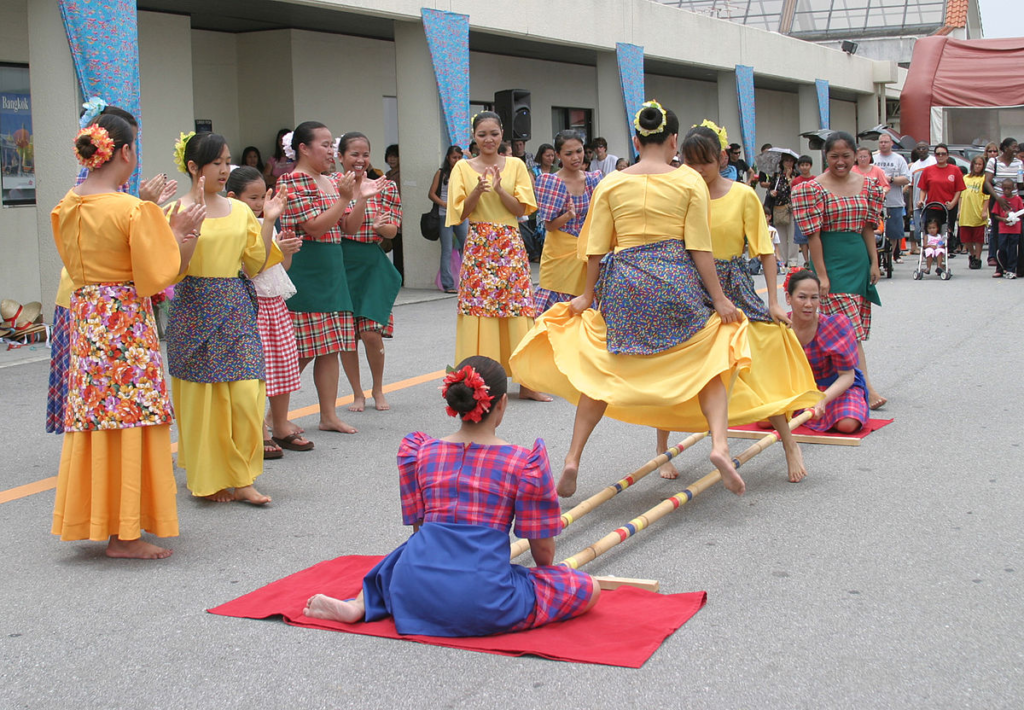
Originating from the province of Leyte, Tinikling is widely celebrated as the most popular folk dance in the Philippines. This traditional cultural dance is so significant it has been recognized as the National Dance of the country.
The name “Tinikling” is derived from the “tikling” birds found in the Philippines. In a delightful mimicry of these birds, dancers agilely move and hop, evading the clapping of bamboo poles that mimic the traps set by farmers.
The dance consists of two pairs, traditionally a male and female dancer, who move with synchronized steps between a set of two bamboo poles that are 9 feet long and placed parallel to each other on the floor. The poles are moved in rhythm with the music and clapped together, representing the nature of the tikling bird’s escapade.
The dancers perform an elaborate sequence of movements including singles, doubles, and hops, which sophistication is dependent on the beat and rhythm created by the bamboo poles. The combined effect is a captivating representation of the harmonious coexistence of humans and wildlife pictured through this enchanting dance form, making Tinikling an integral part of Filipino heritage and cultural pride.
Cariñosa

Cariñosa, a Philippine folk dance which originated from Panay Island, epitomizes the gracefulness and delicate charm of Filipina women during the Spanish Colonial Period. This dance exemplifies the Maria Clara-like qualities, a prominent character in Dr. Jose Rizal’s novel, “Noli Me Tangere,” who displayed grace, modesty, and femininity.
The Spaniards introduced Cariñosa during their colonization of the Philippines, and since then, the dance has become a beautiful representation of the blend of cultures native to the country. Cariñosa is a romantic courtship dance performed by male and female pairs, showcasing their flirtatiousness and delightful interaction.
The dance consists of elegant movements with the use of props, such as fans and handkerchiefs. The dancers hide and peek behind the fans and handkerchiefs, playfully teasing and attracting each other. Their graceful maneuvers are accompanied by traditional Filipino music that enhances the overall atmosphere of the courtship.
Throughout the dance, the male partner seeks the affection of the female partner, while she coyly responds to his advances in a captivating and intriguing manner. The Cariñosa is an enchanting reflection of the Filipino culture’s unique blend of native and Spanish influences, making it an essential piece of Filipino folklore and an enduring symbol of Filipino romanticism.
Itik-Itik

Itik-Itik is a uniquely captivating Filipino folk dance that mirrors the movements of a duck. The dance imitates the way a duck walks, waddling side to side, and how it splashes water onto its back to attract a mate. Itik-Itik showcases the creativity and vibrant culture of the Philippines, as it integrates the playful spirit of nature and animals into a traditional dance form.
The origins of the dance hail from popular tradition, which attributes its creation to a woman named Kanang. As the story goes, Kanang was attending a baptismal party when inspiration struck, and she began choreographing the charming dance. As she performed, other guests at the party joined her, mimicking her steps and embracing the delightful movements resembling the mannerisms of a duck.
Itik-Itik’s unique and appealing choreography was so well received that it was passed down through generations, eventually becoming an integral part of Filipino folk dance culture. This spirited dance serves as a reminder of the beauty of nature, the importance of staying connected with our surroundings, and the power of human creativity in the arts.
Today, the Itik-Itik continues to capture the hearts and imaginations of those who witness this whimsical performance, emphasizing the irresistible charm and rich, diverse culture of the Philippines.
Pandanggo sa Ilaw

Pandanggo sa Ilaw, a cultural jewel originating from Lubang Island, Occidental Mindoro, is one of the Philippines’ most iconic traditional dances. Translated as the ‘Fandango with the Light,’ this dance is a mesmerizing spectacle of grace, balance, and delicacy.
The dancers, with profound skill and agility, balance oil lamps or glasses with candles inside – one on the top of their head and one on each hand – while they swirl, step, and sway in rhythm. The careful dance steps, reminiscent of a Spanish fandango, add a hypnotic allure to the complexity of the dance.
This native Filipino folk dance is performed in 3/4 time, with dancers moving their feet and arms to the rhythmic casting of castanets. The flickering flames from the oil lamps or candles within glasses create a captivating play of light, casting a magic spell on the audience, evoking a sense of enchanting traditional folklore and heritage.
Pandanggo sa Ilaw is more than just a traditional dance; it is an embodiment of elegance under pressure, delicate balance under movement, and the mesmerizing flamboyance of dancing lights. This dance truly interprets the beauty, resilience, and radiance of Filipino culture, making it an integral part of the traditional Filipino dance repertoire.
Sayaw sa Bangko
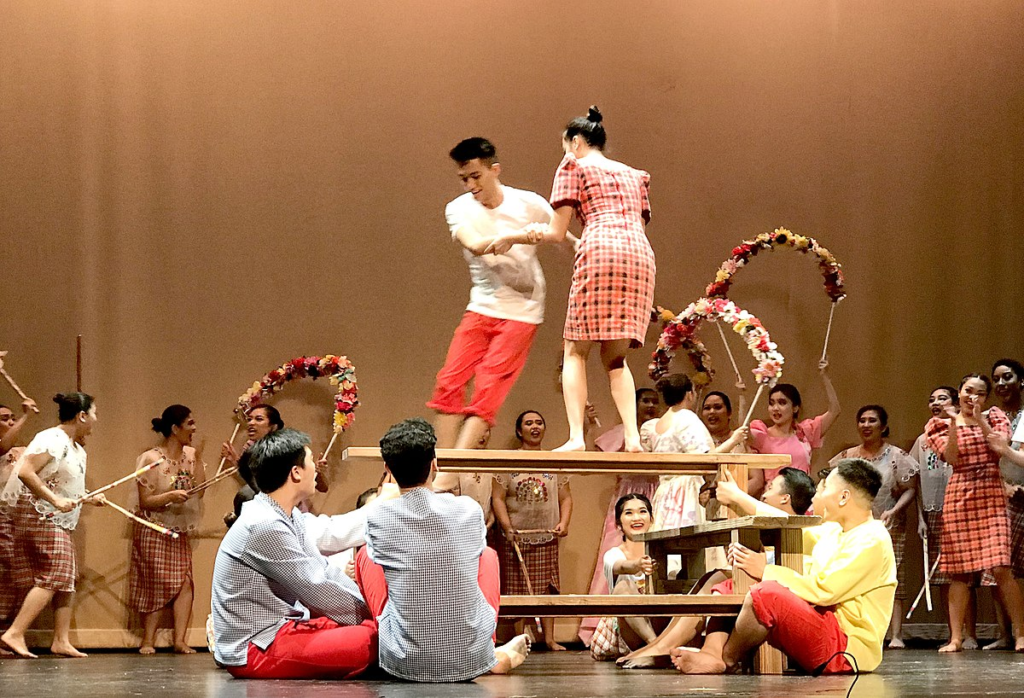
Sayaw sa Bangko, translating to “Dance on the Bench,” is a culturally rich and challenging traditional Filipino dance tracing its origins back to the areas of Pangapisan, Lingayen, and Pangasinan. The dance is strikingly performed on top of a narrow bench, requiring a high degree of balance, precision, and skill from the performers.
Traditionally, male-female pairs of dancers take their stance on the bench to carry on intricate and synchronized movements. While maintaining an exceptional balance, the dancers gracefully perform a variety of maneuvers and sequences, ranging from exchanging positions to leaping over one another. The dance also incorporates some astonishing acrobatics, which add spontaneity and excitement to the performance.
The coordination, agility, and perfect timing necessary to perform Sayaw sa Bangko reflect the discipline and focus required in the dance. The dancers must intuitively sense the movements of their partners to avoid missteps and ensure the smooth flow of the dance.
Sayaw sa Bangko is not just a dance; it’s a high-energy performance of trust, precision, and teamwork, making it a compelling demonstration of Filipino cultural heritage. It continues to enthrall audiences with its unique and surprising blend of acrobatics, dance, and daring, cementing its place in the rich tapestry of Filipino traditional dances.
Kuratsa
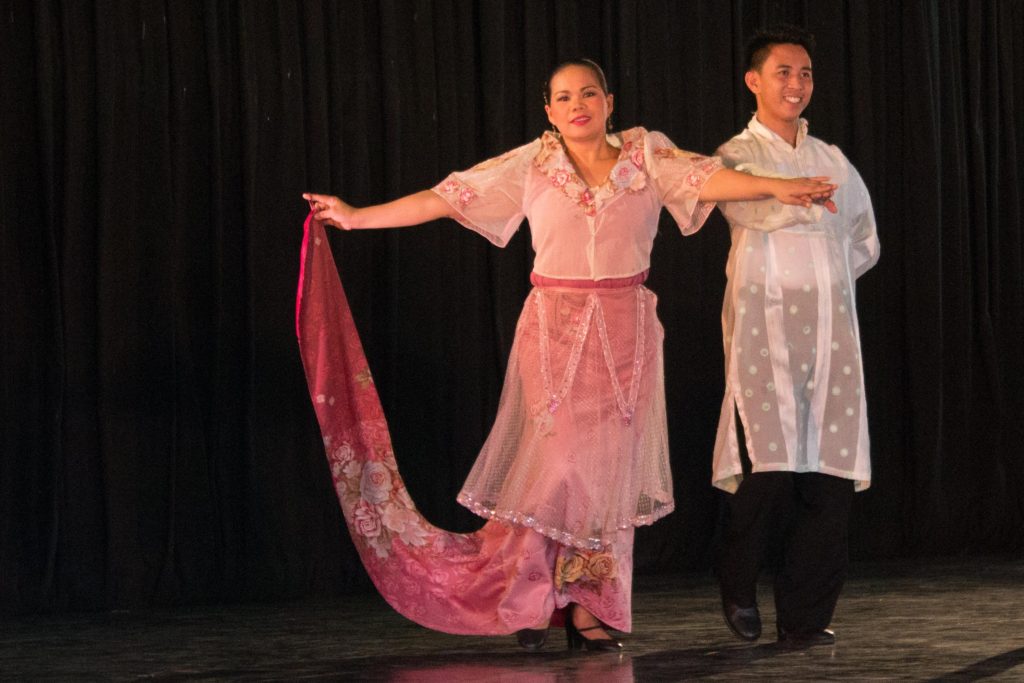
Kuratsa is an expressive traditional Filipino folk dance that hails from Samar Island. Often performed at weddings and social gatherings, Kuratsa is a courtship dance that playfully imitates the mating dance between a rooster and a hen. This dance highlights Filipino humor, artistry, and the traditional courtship rituals embedded in the culture.
Kuratsa has a three-part choreography which parallels the rooster’s approach towards the hen. In the first part, reminiscent of a waltz, a male and female dancer perform in gracious harmony, reflecting the introduction stage of courtship. The dance begins with smooth movements and modest interactions, setting the tone for the proceeding stages.
The second part introduces the chase wherein the male dancer engages in active pursuit of the female dancer, mimicking a rooster courting a hen. This theatrical segment showcases the energy, enthusiasm, and anticipation of the dance, capturing the humor and challenges of courtship.
The final part symbolizes the culmination of courtship wherein the male dancer finally wins over the female dancer with his dance. The sense of achievement and satisfaction is expressed through a final, more relaxed dance, signifying the successful end of the chase.
The Kuratsa marvelously captures the nuances of courtship rituals, making it an engaging performance that brims with cultural significance. Beyond mere entertainment, it provides audiences with a glimpse of Filipino social traditions, specifically pertaining to courtship and social interactions.
Sinulog

Sinulog is a dynamic and spectacular traditional Filipino dance that celebrates and pays tribute to the Santo Niño, or the Holy Child Jesus. Known for its vibrant colors, elaborate costumes, and energetic, synchronized choreography, Sinulog is a grand display of devotion and cultural pride, captivating the hearts of spectators and fostering a spirit of unity among participants.
This visually arresting dance features participants dressed in brightly colored and intricate costumes that reflect the richness of Filipino artistry. Enhancing the dance’s appeal, performers often embellish their attire with eye-catching accessories and ornaments, giving life to the exuberant atmosphere of the cultural event.
Choreographically, Sinulog boasts of lively and coordinated movements, intricately weaving together rhythm, agility, and teamwork. Performers move around in synchronization to the beating of drums, creating an enthralling visual spectacle. The dance’s hallmark steps include a two-step forward, one-step backward movement, intended to represent the flow of a river’s current.
Sinulog is more than just a dance; it is a powerful expression of the Filipino people’s spirituality and cultural identity. Every step, every beat, every movement, pulsates with a collective fervor that exudes dedication, reverence, and a sense of communal celebration.
Through the captivating colors, intricate choreography, and the soulful spirit of Sinulog, this cultural masterpiece continues to play a pivotal role in preserving and showcasing the Philippines’ deeply rooted traditions and sense of community.
Maglalatik
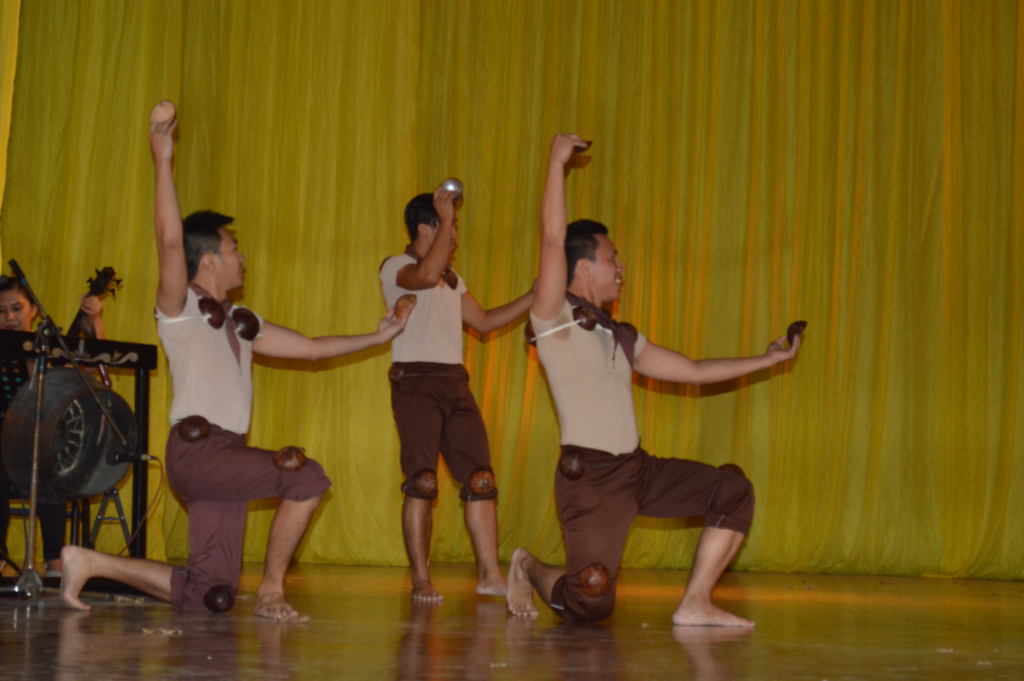
The Maglalatik is a unique mock war dance from the Philippines that stages a playful fight over coconut meat, a coveted component of the local diet. Captivating for its symbolisms, unique wardrobes, and rhythmic choreography, the Maglalatik is an illustrative piece of Philippine folk performance artistry.
The dance involves four distinct parts, divided between depicting conflict and reconciliation. The first two parts introduce the battle over coconut meat, unveiling a fierce and energized dance performance marked by aggressive movements and active engagement between dancers. The latter two parts then transition into reconciliation, wherein the dance’s intensity softens to represent truce and unity, symbolizing a harmonious resolution.
One of the distinctive features of the Maglalatik is the attire of the male dancers, which includes the innovative use of coconut shells. These shells are fastened on the dancers’ bodies, serving as both protective armor and percussive instruments. As the dancers perform, they rhythmically slap the coconut shells, echoing the beats of the music and adding an extra dimension to the performance’s auditory landscape.
Performed during the fiesta of Biñan as a religious offering to San Isidro de Labrador – the patron saint of farmers, the Maglalatik dance holds a significant place in the hearts and culture of the local community. Its incorporation of everyday elements like the coconut and its dynamic portrayal of conflict and harmony make it a unique, engaging, and reflective depiction of Filipino culture and tradition.
Pandanggo Oasiwas
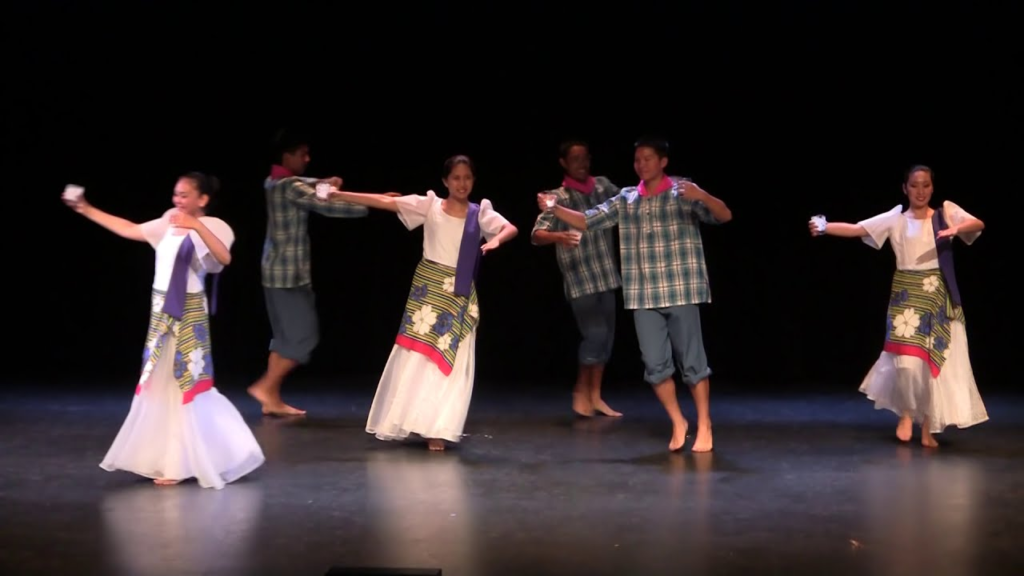
Pandanggo Oasiwas, often likened to its cousin the Pandanggo sa Ilaw, stands as a treasured cultural symbol originating from the fishing community of Lingayen in Pangasinan, Philippines. This joyous show of gratitude and celebration is typically enacted by fishermen after a bountiful catch.
In this version of the dance, the performers utilize lamps (or ‘ilaw’) that are carefully ensconced in cloths or nets. As the dance progresses, the lamps in their protective covers are swirled and swung around, creating a sight of glowing orbs moving rhythmically around the dancers.
Much like its counterpart, dancers move in a 3/4 beat, similarly illustrating an enchanting mirror of a Spanish fandango. Yet, the Pandanggo Oasiwas sets itself apart as the dancers do not just sway or step, but also circle around dynamically, adding a captivating layer to the performance.
The synchronization of the dancers, combined with the music and the artistically swung lamps, creates a luminous spectacle. The twirling lamps in motion enhace the festive spirit of the dance, ingeniously simulating the sparkle of fireflies at dusk.
Pandanggo Oasiwas is much more than a folk dance. It is a testament to the fishermen’s life, their deep connection with the sea, and their collective celebratory spirit after a fruitful harvest. As such, it holds a significant place in the rich canvas of Filipino cultural dances, encapsulating the essence of community, gratitude, and joyous exuberance.
Subli
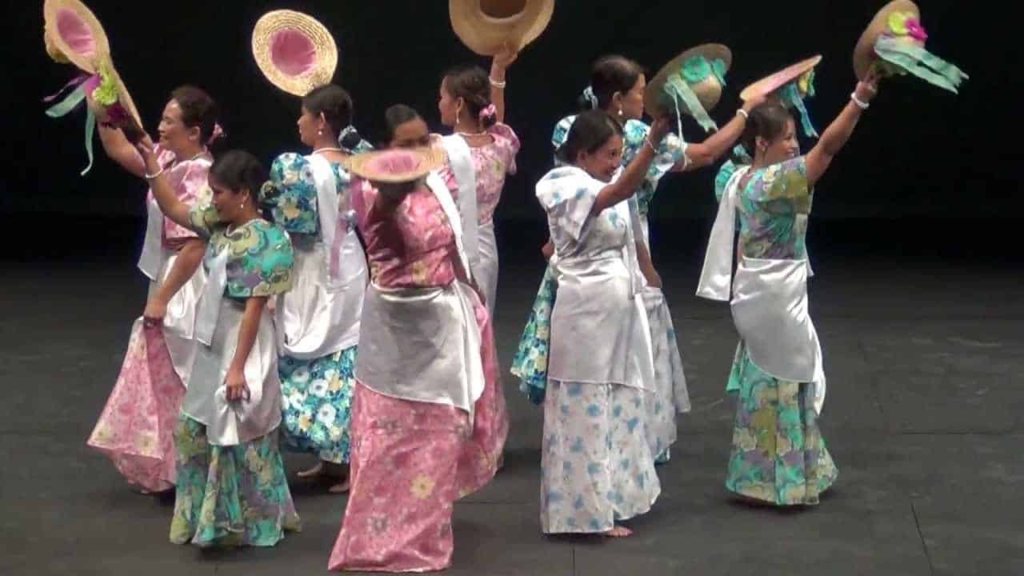
Subli is a traditional Filipino folk dance hailing from Bauan, Batangas, whose origins are deeply entwined with religious devotion. This dance is performed in honor of the Holy Cross of Alitagtag, the patron saint of the Municipality of Alitagtag, representing a colorful cultural manifestation of faith and reverence.
The dance involves male and female performers, each personifying distinct characters and roles within the choreography. It showcases the performers’ expertise and learnedness, requiring coordination, rhythm, and an intuitive understanding of traditional dance movements.
The male dancers demonstrate their skill by rapping castanets, a pair of shell-shaped percussion instruments, accentuating the music and adding a vibrant auditory texture to the dance. Their vigorous movements and rhythmic stepping complement the more subtle and graceful moves of the female dancers.
On the other hand, the female dancers elegantly sway in a circular motion, upholding their brimmed hats, symbolically presenting an offer of respect and veneration. Their movements resonate with grace and poise, harmonizing with the overall rhythm of the dance.
Subli is characterized by a combination of hopping and sliding movements, embodying a unique dance technique that adds to its cultural appeal. This dance epitomizes a blend of faith, expression, and community participation, encapsulating the vibrant spirit of the local culture and traditions. Through the Subli, the people of Bauan continue to honor their religious heritage, strengthening their cultural identity with every hop, slide, and sway.
Kappa Malong-Malong
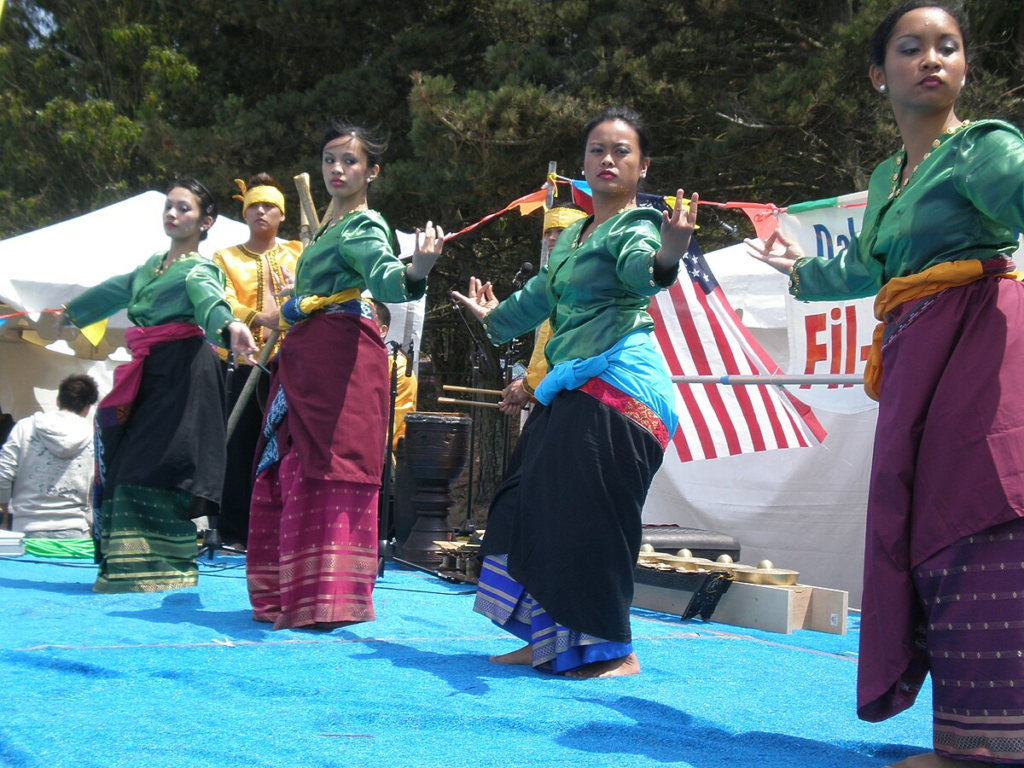
Kappa Malong-Malong is an expressive tribal dance hailing from the Maranao tribes of Mindanao in the Philippines. Noted for its display of versatility and unique cultural symbolism, the dance features a significant tubular garment, the malong, portraying its multifaceted uses and its integral role in Maranao culture.
During the dance, performers creatively demonstrate how the malong can be used in varied ways, transforming it into a headdress, a shawl, a skirt, among other forms. This act of transformation not only testifies to the resourcefulness of the Maranao people but also highlights the malong’s status as a cultural icon embedded in their daily lives.
The dance, however, isn’t just a practical demonstration; it is also imbued with deep cultural significance for the Maranao tribe. A tribesman will often possess the same malong from birth until death, underlying the malong’s importance as a well-cherished possession and a symbol of a person’s life journey within the tribe.
Kappa Malong-Malong is, thus, more than merely a tribal dance. It’s a vibrant chronicle of the Maranao people’s lifestyle and their profound connection to the malong. Each motion speaks to the tribe’s customs, values, and history, showing that the dance, like the malong itself, is truly versatile, wrapping within itself layers of cultural significance.
Singkil
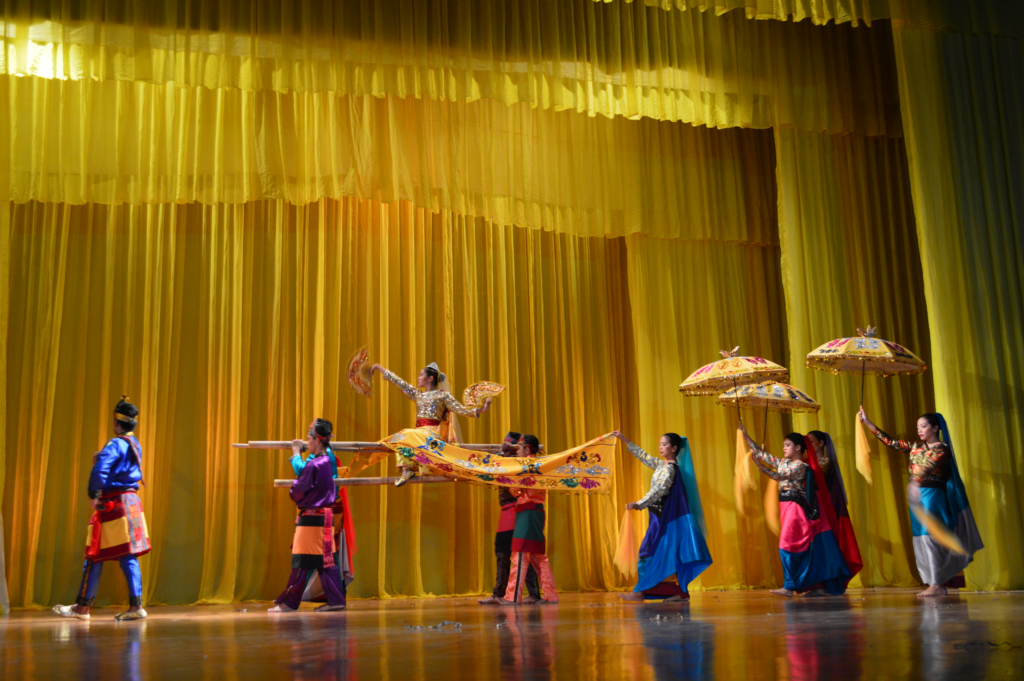
Originating from the Maranao tribes of Mindanao, Singkil is a Filipino traditional dance that captures the imagination with its roots in folklore and distinctive choreography. Its name, which implies the act of “getting a leg or foot entangled in an object” or “to entangle the feet with disturbing objects such as vines,” hints at the dance’s unique interplay between grace, agility, and finely-tuned movements.
Singkil was originally performed by a solo female dancer, accompanied by the rhythmic beating of bamboo poles upon which she must intricately maneuver. The lead dancer typically makes use of a fan or scarf, gliding gracefully in and out of the crisscrossing arrangement of bamboo poles, displaying an enchanting display of skill and elegance.
According to traditional accounts, Singkil has its roots in Darangen, a pre-Islamic Maranao interpretation of the ancient Hindu Indian epic Ramayana. This rich historical context further elevates the dance’s cultural significance and mystique. Its origins lend depth and meaning to the performance, linking it to a heritage that predates the current era.
Additionally, Singkil was customarily performed by young maidens seeking to catch the eye of potential suitors. The dance not only showcased the grace and agility of the performer but also symbolized her suitability as a wife and her place within the community.
Singkil is a captivating display of artistry that blends cultural heritage, graceful movements, and intriguing origins. This enchanting dance continues to captivate audiences, leaving them enthralled by the sophisticated interplay of tradition, technique, and folklore.
La Jota Moncadeña

Regarded as a cultural emblem from the region of Moncada, Tarlac, La Jota Moncadeña, or Jota Florana as locals call it, is a striking representation of a dance form that has successfully amalgamated vibrant cultures. This dance is a Filipino adaptation of the traditional Jota, a well-loved courtship dance from Aragon, Spain, that has been artistically tailored to the Filipino taste.
La Jota Moncadeña interestingly combines Spanish dance patterns with Ilocano steps, creating a unique blend that retains the charm of both cultures. The dancers clap castanets in their hands, adding rhythm to the lively footwork and creating a captivating auditory experience. The dance is typically performed to the tunes of traditional Spanish music, enhancing the feel of its roots while celebrated in a Filipino context.
This dance is reserved for special celebrations and communal gatherings, where its vibrant performance adds to the festive atmosphere and bolsters the spirit of shared heritage. However, it is not just limited to joyous occasions. A more solemn and subdued version of La Jota Moncadeña is performed for funeral processions, accentuating the rite’s gravity and respectfulness.
La Jota Moncadeña represents more than a mere dance; it is a testament to the shared historical and cultural links between Spain and the Philippines. It is a captivating expression of harmony between two cultures, one that continues to resonate with audiences for its captivating movements and the cultural integration it signifies.
Surtido
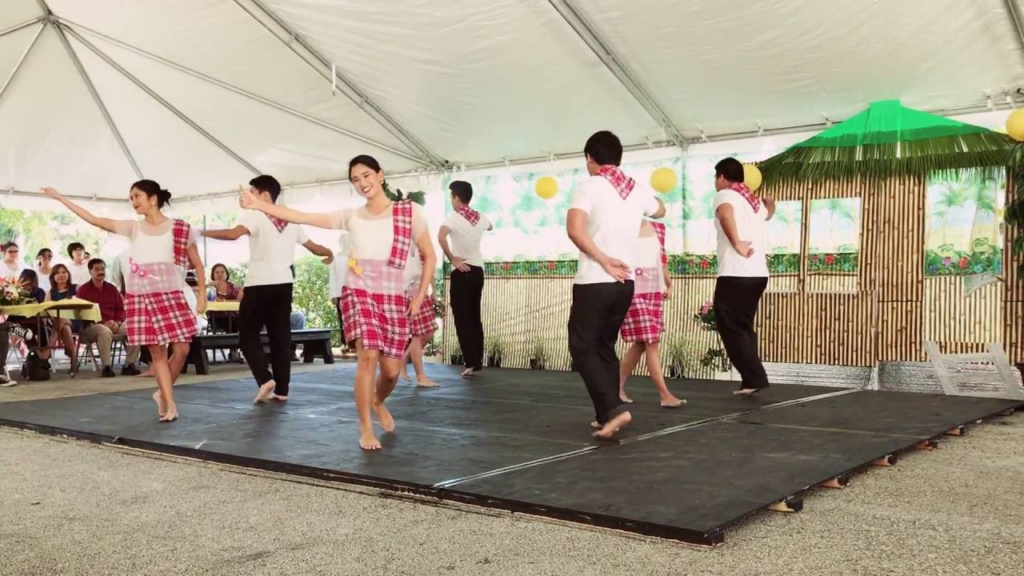
Hailing from Bantayan, Cebu, Surtido, also known as Surtido Cebuano, is a distinct and lively square dance that reflects an assortment of cultural influences, including elements from Spanish, Mexican, and French dance forms. This dance embodies diversity in unity, with the varied influences harmonizing into a singular, captivating performance.
The term ‘Surtido’ translates to ‘assortment’, mirroring the dance’s eclectic mixture of movements and formations. A key highlight of Surtido is the execution of varying quadrille formations, a characteristic feature of classical European dances, performed by the costados (sides). Leading the progression of the dance are the cabeceras (heads), ensuring a well-coordinated display of the colorful cultural amalgamation.
Designed for group participation, Surtido is characterized by a rhythmic ebb and flow of dancers moving synchronously in geometric formations, presenting an array of vibrant patterns. This coordination and complexity make the Surtido an entertaining and intriguing performance, amplifying the spirit of communal participation and shared cultural expression.
Surtido, with its international influences and local interpretations, is more than just a dance. It is a celebration of the Filipino spirit that embraces and assimilates varied cultural aspects, and an affirmation of the diversity that exists within unity. A performance of Surtido is a visual spectacle of seamlessly integrating and honoring multiple cultural facets.
Pantomina

Pantomina, a traditional Bicolano courtship dance, is a cherished part of wedding celebrations in Bicol, where nuances of love and courtship are beautifully reenacted by the newlywed couple. The name ‘Pantomina’ arises from ‘pantomime,’ — a performance that conveys a narrative using gestures without speech — reflecting the dance’s storytelling aspect of a courtship and mating ritual.
This regional folk dance cleverly mimics the courting movements of doves, capturing their gentle maneuverings and symbolic messages through a series of refined and expressive movements. The dance delivers an evocative rendition of love, played out through the couple’s performance, intricately manoeuvring to showcase a charming wooing process between the two birds.
The wedding guests traditionally contribute to the couple’s prosperity by showering them with coins or placing cash on a plate set on the ground as the couple dance. This unique culminating feature of the Pantomina adds a layer of goodwill and blessing to the dance, marking the newlyweds’ journey with prosperity.
First brought to light by Francisca Reyes-Aquino, known as the Mother of Philippine Dancing, Pantomina’s documentation in her 1926 research made it accessible to the wider world, thereby raising its cultural significance.
Pantomina continues to serve as a heartwarming spectacle of love and prosperity at Bicolano wedding feasts. This dance, with its courtship rituals and symbolic gestures, illustrates a vivid tableau of enduring love, nuptial blessings, and traditional customs to this day.
Binasuan

Originating from Pangasinan, Binasuan is a Filipino folk dance showcasing the nimble dexterity and graceful agility of the dancers. The dance involves a unique element, wherein performers balance drinking glasses filled with rice wine on their heads and hands, drawing a parallel with the well-known Pandanggo sa Ilaw.
As one of the most taxing Philippine folk dances, Binasuan demands tremendous concentration, elegance, and dexterity from the performers. The challenge lies not just in maintaining the balance of the glasses, but also in ensuring that the rice wine doesn’t spill — a fine test of poise and control.
Typically featured at weddings and festivals, Binasuan occasionally transforms into a friendly competition choreographed for entertainment, wherein dancers strive to outdo each other in balancing the wine-filled glasses. Its vibrant performance feature adds an exciting dimension to these festivities.
Supporting and promoting Philippine folk dances like Binasuan are deeply significant in preserving these art forms for future generations. They serve as vital links to a region’s cultural, historical, and religious roots, reflecting and narrating the customs and traditions of the Philippine society.
The continuous celebration of folk dances offers society a window into its cultural legacy, fostering a greater understanding of its cultural identity. The significance of Binasuan, along with other Philippine folk dances, lies not just in their performance but also in their powerful narration of the region’s vibrant cultural tapestry.
Habanera Botolena
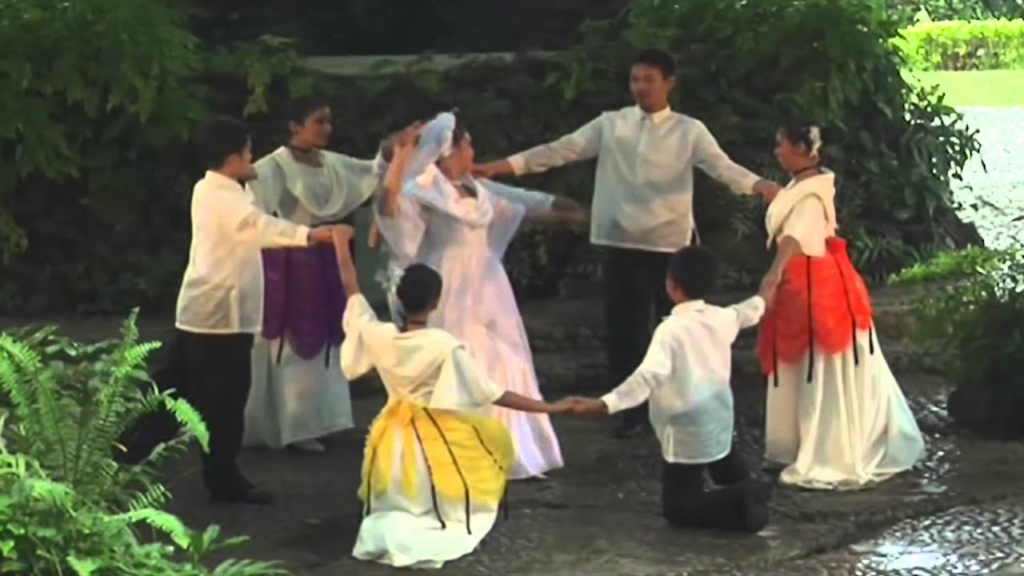
Habanera Botolena, a dance rooted in the region of Botolan, Zambales, epitomizes the perfect blend of Filipino and Spanish cultural elements. Echoing the passionate energy of flamenco, this dance style intertwines sensuality with a playful character, creating an enchanting spectacle for audiences.
Incorporating traditional Spanish dance with Filipino grace, the Habanera Botolena borrows intricate steps and movements from both cultures. Its unique synthesis allows dancers to express their emotive depth, reflecting the fervor of Spanish flair while retaining the subtlety of Filipino artistry.
Often seen at wedding celebrations, Habanera Botolena is a fitting dance to accompany the union of two hearts, signifying the merriment and joy shared by loved ones. Known for its expressiveness, it is not uncommon for this dance to also serve as a courting ritual in some situations.
The Habanera Botolena represents the seamless fusion of two powerful cultural influences, celebrating their intricacies and distinctions in a harmonious dance form. Its strong flamenco flavor, combined with a captivating choreography, celebrates the passion of love while reminding us of the connected history of the Philippines and Spain.
Polkabal

The Polkabal is a lively Filipino folk dance that is a unique blend of local and foreign forms, heavily featuring European influences in its dynamic steps. Evolving from the Polka and mixed with the cultural elements of the Philippines, this dance showcases a vibrant harmony of origins and styles.
Arguably one of the most diverse and dramatic Filipino folk dances, Polkabal is composed of nine distinct steps that add texture and variety to the performance. The steps encompass a broad range of movements, traipsing from fluttery, swift runs to measured, heel-to-toe sequences. These dance movements illustrate a narrative, visualizing scenes such as a bullfight or a casual, leisurely walk.
Evoking an aura of festivity and celebration, the Polkabal’s energetic rhythms, and intricate footwork, paired with passionate, expressively enacted scenarios, create a captivating visual treat. The dancers expertly transition between the different steps, weaving a tapestry of movement that is both varied and coherent.
The Polkabal is a testament to the adaptability of Filipino cultural forms, absorbing international influences while maintaining their essence. A dance of intricate footwork, expressive enactments, and cultural fusion, Polkabal remains an entertaining and meaningful representation of the Filipino cultural fabric.
Magkasuyo
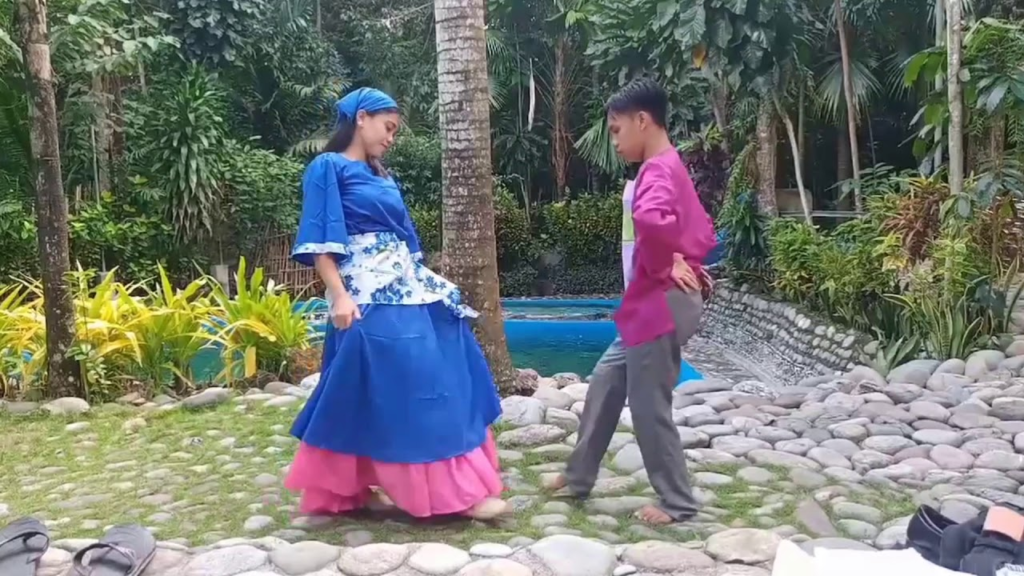
Magkasuyo, hailing from the culturally rich Quezon province of the Philippines, translates to ‘being in love,’ perfectly capturing the essence of this delightful, courtship-oriented dance. Rooted in the rhythmic grounds of balse, or waltz, Magkasuyo borrows the one-two-three rhythm, imparting a grace that is unmistakably reminiscent of Spanish traditions.
Derived from the balse’s formal series of close-step-close movements, partners romantically engage in this dance face to face in a duel of attraction. The Magkasuyo dance, while incorporating German and Spanish influences, is a product of significant local inventiveness, uniquely imbibing elements from a rich array of cultures including Spanish, Malay, and Muslim traditions prominent in the Quezon province.
This dance carries a romantic layer that is intricately woven into its rhythm and movements. The popular Tagalog song, “Magkasuyo Buong Gabi” (Lovers for the Night), enriches the romantic narrative of the dance, its lyrics encapsulating the tender emotions experienced by the dancers.
Magkasuyo, as the province’s specific creation, honours Quezon’s diverse cultural influences and boasts of its regional heritage. It is not just a dance; it is a tender portrayal of love and courtship, enlivened by the song and the entrancing rhythm of the waltz.
Dugso
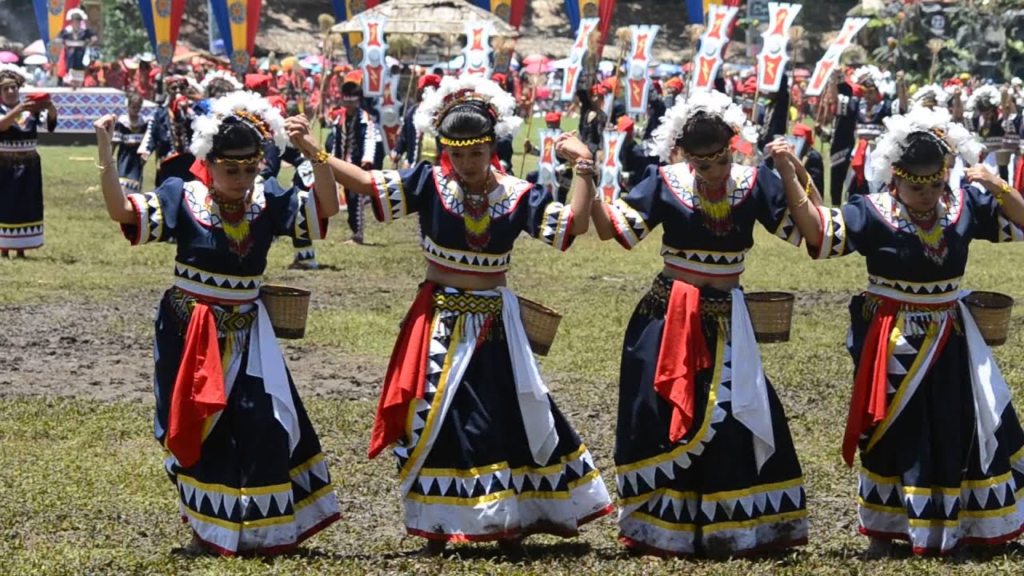
Dugso, a ceremonial dance practiced by the indigenous Manobo, Higaonon, and Talaandig tribes, represents a spiritual connection between the community and their deities. Performed with deep reverence, this dance serves as a supplication to their gods, invoking blessings of protection and prosperity through bountiful harvests.
Empowered by a pulsating energy, Dugso is distinguished by its unmistakable rhythmic stomping and jumping movements. Dancers adorned in vibrant, elaborate attire energetically express their gratitude, simultaneously imploring the divine for continuous favor. The animated beats and lively choreography unite the dancers and the tribal community in a harmonious act of veneration and thanksgiving.
Traditionally performed during significant events like harvest time, the foundation day of a community or religious rituals, Dugso bears a profound spiritual and cultural significance. As an indispensable part of these tribes’ identity, this symbolic dance transcends entertainment, exemplifying unity, devotion, and a deep-rooted reverence for the higher powers believed to govern their lives.
Dugso is a captivating visualization of the rich cultural and spiritual wealth of the indigenous tribes of the Philippines. The dance is a testament to their collective faith, manifesting the timeless bond between a community and their respected deities.
Concluding Remarks
The captivating tapestry of the “Rhythms of the Islands: Top 20 Most Popular Philippine Folk Dances” presents a rich panorama of the Philippines’ cultural heritage. As we navigate through each dance, we explore the distilled essence of various regional communities, aligning ourselves with their vibrant traditions, rich histories, and distinctive narratives.
These folk dances, though incredibly diverse, each tell stories of love, courtship, celebration, and reverence typical of communal life. They showcase the inherent grace and agility of Filipino performers while echoing unique cultural influences and ancestral legacies. From Binasuan’s meticulous handling of glasses to Magkasuyo’s enacted tales of romance, to Dugso’s pulsating rhythm paying homage to the divine—each dance imparts distinct flavors and emotions.
Seeing these dances come alive, one feels the ebbs and surges of the Philippine archipelago’s rhythm, running deep within its people’s veins, across generations. This exploration drives home the importance of upholding and celebrating these folk dances, which serve as an evocative testament to the Philippines’ rich tapestry of influences and expressions. Truly, “Rhythms of the Islands: Top 20 Most Popular Philippine Folk Dances” offers a vibrant journey into the heart of the Philippines’ cultural identity.
Leave a Reply